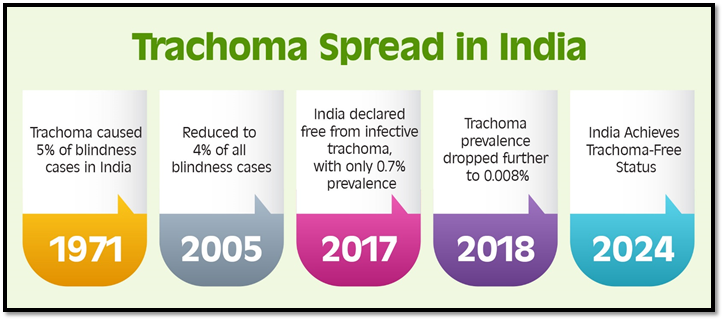India Eliminates Trachoma as Public Health Concern
Why in the news?
India has achieved a significant public health milestone by eliminating trachoma, reducing its prevalence to 0.7%, with important implications for health and economic productivity.
Achievement in Public Health:
- India has successfully eliminated trachoma as a public health problem, reaching a prevalence rate of7%.
- This milestone reflects significant public health progress, reducing the economic burden associated with blindness and visual impairment, which previously cost the country an estimated $2.9 to $5.3 billion
- The success is attributed to the World Health Organization’s SAFE strategy (Surgery, Antibiotics, Facial cleanliness, and Environmental improvements).
Continuing Efforts Needed:
- Despite the significant achievement, sporadic cases may still arise, emphasising the need for ongoing surveillance and public health initiatives.
- Maintaining elimination status requires consistent efforts, including improved sanitation, health education, and regular surveys by the National Programme for Control of Blindness and Visual Impairment.
- Continued dedication to the SAFE strategy and initiatives like Swachh Bharat is essential to ensure trachoma remains a disease of the past and to eliminate other neglected tropical diseases in the future.
Key points:Trachoma
- Leading Cause of Blindness: Trachoma is the world’s foremost infectious cause of blindness.
- Cause: Caused by Chlamydia trachomatis, a bacterium spread through direct/indirect contact with infected discharges or by certain flies.
- Main Reservoir: Young children are primary carriers; prevalence can reach 60-90% in endemic areas.
- Transmission: Primarily occurs within households; re-infections are common in endemic regions.
- Disease Progression: Repeated infections lead to scarring, trichiasis, and eventual blindness if untreated.
- Risk Factors: Poor hygiene, overcrowding, limited water access, and inadequate sanitation.
- Impact on Women: Women are at four times higher risk than men, often due to child care duties.
- Global Presence: Mainly affects impoverished areas in Africa, Asia, and Latin America, responsible for 1.4% of global blindness.
Key Initiatives to Combat Trachoma in India:
- National Trachoma Control Program (1963): Launched to manage trachoma via surgery, antibiotics, hygiene, and environmental improvements.
- Integration into NPC BVI (1976): Trachoma control merged with the National Programme for Control of Blindness and Visual Impairment.
- Progress: Trachoma-related blindness reduced from 4% in 2005 to 0.008% in 2018, achieving elimination targets in endemic areas.
Sources Referred:
PIB, The Hindu, Indian Express, Hindustan Times




